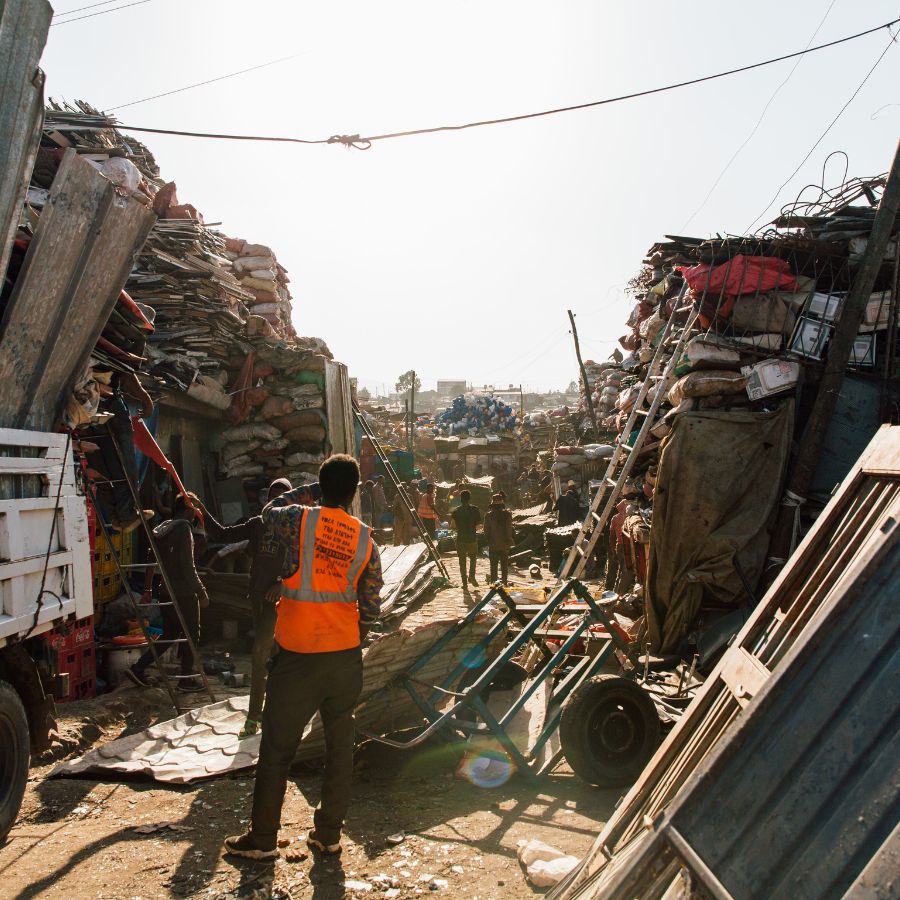Imagine if every piece of discarded metal could help combat climate change. That’s exactly what industrial scrap metal recycling achieves.
In today’s fast-paced industrial world, factories, construction sites, and manufacturing plants generate tons of metal waste every day. Without proper recycling, this waste ends up in landfills, polluting the environment and wasting valuable resources.
But industrial scrap metal recycling changes that narrative. It transforms waste into reusable materials, reducing the burden on our planet and supporting a cleaner, more sustainable future.
Industrial scrap metal recycling refers to collecting, sorting, processing, and reusing metals from industrial operations. It involves both ferrous metals (like steel and iron) and non-ferrous metals (such as copper, aluminum, and brass).
These metals are melted down and refined to create new products, minimizing the need for fresh mining and metal extraction.
Globally, industries produce millions of tons of scrap metal each year. Much of it comes from automotive, construction, and manufacturing sectors.
Without proper recycling, this metal waste contributes to land pollution, soil contamination, and resource depletion. Industrial recycling facilities play a critical role in collecting, refining, and reusing this scrap responsibly.
Landfills are already overflowing with non-biodegradable waste. Scrap metals occupy valuable space and never decompose, leading to long-term environmental hazards.
By recycling metals, industries significantly reduce the volume of waste that ends up in landfills. This helps extend landfill lifespan and prevent soil degradation.
When metals like lead, mercury, or cadmium are dumped, they leach toxic chemicals into soil and groundwater. This contaminates ecosystems and threatens public health.
Recycling ensures these metals are processed safely, preventing environmental poisoning and safeguarding water resources.
Proper recycling systems also mean cleaner, more organized industrial areas. It reduces clutter, decreases health hazards, and contributes to a more efficient workspace.
Mining for virgin metals like aluminum, copper, and steel devastates ecosystems. It causes deforestation, destroys habitats, and pollutes water bodies.
Each ton of newly mined metal requires immense energy and water, leaving behind a heavy environmental footprint.
Recycling metals eliminates the need for constant mining. Every ton of steel recycled saves about 1.5 tons of iron ore and 0.5 tons of coal.
Similarly, recycling aluminum saves up to 95% of the energy required for raw production, reducing pressure on natural reserves.
Countries with strong recycling programs, like Japan and Germany, have reduced mining dependency while maintaining industrial growth. This balance proves that sustainability and productivity can go hand-in-hand.
Primary metal production — especially smelting and refining — releases massive amounts of greenhouse gases. These emissions contribute to global warming and air pollution.
Recycling drastically reduces energy consumption, leading to lower CO₂ emissions. For example, recycling aluminum reduces emissions by over 90% compared to mining new ore.
When industries choose recycling, they directly contribute to lowering their carbon footprint.
Recycling initiatives align with global sustainability targets such as the Paris Agreement and net-zero carbon commitments. By reusing scrap metal, businesses actively support climate-positive operations.
Producing new metals from raw ore requires immense amounts of energy — for mining, transportation, and refining.
In contrast, recycling uses only a fraction of that energy. For instance:
- Aluminum recycling saves up to 95% of the energy.
- Steel recycling saves around 60–70%.
- Copper recycling saves up to 85%.
These energy savings directly translate into fewer fossil fuels burned and lower emissions.
Many factories have adopted closed-loop recycling systems where metal waste from production is recycled back into the manufacturing process. This not only saves energy but also improves operational efficiency.
A circular economy focuses on reusing, repairing, and recycling materials to create a sustainable cycle.
Industrial metal recycling is a cornerstone of this system — it keeps valuable resources circulating instead of being discarded.
Manufacturers increasingly rely on recycled metals to produce high-quality goods while maintaining environmental responsibility. This approach creates a green supply chain, lowering costs and carbon impact simultaneously.
Companies that integrate recycling into their business model showcase environmental accountability. It strengthens their brand reputation, aligns with CSR goals, and attracts eco-conscious customers.
The recycling industry generates thousands of jobs in collection, sorting, processing, and logistics. It empowers local communities and contributes to sustainable economic development.
Recycling technologies continue to advance — from AI-driven sorting systems to automated refining processes. These innovations enhance recycling efficiency and promote cleaner production methods.
When industries lead in recycling, communities follow. It encourages local participation in waste management and nurtures environmental awareness.
Industrial recycling faces hurdles like material contamination, high processing costs, and fluctuating metal prices.
Additionally, lack of awareness among some manufacturers limits participation.
Innovations such as AI-based sorting and smart recovery systems are transforming recycling plants. These advancements improve precision, reduce contamination, and increase recovery rates.
With global focus shifting toward sustainability, industrial scrap metal recycling by union metal recycling will play a crucial role in building a carbon-neutral economy. Government policies and corporate initiatives are expected to accelerate progress.
Industries should collaborate with licensed recyclers who follow environmental compliance and ensure proper waste handling.
Setting up separate bins for ferrous and non-ferrous metals helps streamline recycling and boosts recovery rates.
Training staff on proper waste management fosters accountability and efficiency throughout the production chain.
Track recycling progress and include sustainability metrics in annual reports to demonstrate corporate responsibility.
Industrial scrap metal recycling is more than just waste management — it’s a commitment to a sustainable planet.
By reducing landfill waste, conserving resources, cutting emissions, and saving energy, recycling creates an environmental ripple effect that benefits generations to come.
For industries, it’s not only an ecological necessity but also an economic advantage. Every recycled metal piece contributes to a cleaner, greener, and more resilient future.
1. What metals can be recycled in the industrial sector?
Commonly recycled metals include steel, aluminum, copper, brass, and stainless steel — all of which retain their quality even after multiple recycling cycles.
2. How does metal recycling reduce environmental pollution?
By diverting metals from landfills and preventing toxic leaching, recycling protects soil and water quality while minimizing visual pollution.
3. Is industrial scrap metal recycling profitable?
Yes. Businesses save money on raw materials and waste disposal while earning from scrap sales and improving sustainability credentials.
4. Can contaminated industrial metals be recycled?
Yes, but they may require pre-treatment or separation to remove impurities before processing.
5. How does recycling contribute to a circular economy?
It ensures materials remain in circulation, reducing waste and the demand for new raw resources — forming a continuous, sustainable production cycle.

